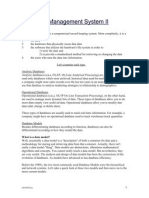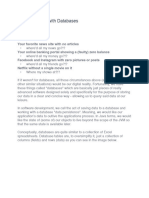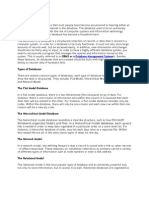SSIS Best Practices
SSIS Best Practices
Uploaded by
Seshu VenkatCopyright:
Available Formats
SSIS Best Practices
SSIS Best Practices
Uploaded by
Seshu VenkatOriginal Description:
Original Title
Copyright
Available Formats
Share this document
Did you find this document useful?
Is this content inappropriate?
Copyright:
Available Formats
SSIS Best Practices
SSIS Best Practices
Uploaded by
Seshu VenkatCopyright:
Available Formats
SSIS Best Practices, Part 2 And as promised, here is my personal list of SQL Server Integration Services best practices.
This is by no means comprehensive (please see my previous post for links to other best practice resources online) but it's a great starting point to avoiding my mistakes (and the pain that came with them) when you're working with SSIS. Here goes: Get your metadata right first, not later: The SSIS data flow is incredibly dependent on the metadata it is given about the data sources it uses, including column names, data types and sizes. If you change the data source after the data flow is built, it can be difficult (kind of like carrying a car up a hill can be difficult) to correct all of the dependent metadata in the data flow. Also, the SSIS data flow designer will often helpfully offer to clean up the problems introduced by changing the metadata. Sadly, this "cleanup" process can involve removing the mappings between data flow components for the columns that are changed. This can cause the package to fail silently - you have no errors and no warnings but after the package has run you also have no data in those fields. Use template packages whenever possible, if not more often: Odds are, if you have a big SSIS project, all of your packages have the same basic "plumbing" - tasks that perform auditing or notification or cleanup or something. If you define these things in a template package (or a small set of template packages if you have irreconcilable differences between package types) and then create new packages from those templates you can reuse this common logic easily in all new packages you create. Use OLE DB connections unless there is a compelling reason to do otherwise: OLE DB connection managers can be used just about anywhere, and there are some components (such as the Lookup transform and the OLE DB Command transform) that can only use OLE DB connection managers. So unless you want to maintain multiple connection managers for the same database, OLE DB makes a lot of sense. There are also other reasons (such as more flexible deployment options than the SQL Server destination component) but this is enough for me.
Only Configure package variables: If all of your package configurations target package variables, then you will have a consistent configuration approach that is self-documenting and resistant to change. You can then use expressions based on these variables to use them anywhere within the package. If its external, configure it: Of all of the aspects of SSIS about which I hear people complain, deployment tops the list. There are plenty of deployment-related tools that ship with SSIS, but there is not a lot that you can do to ease the pain related to deployment unless your packages are truly location independent. The design of SSIS goes a long way to making this possible, since access to external resources (file system, database, etc.) is performed (almost) consistently through connection managers, but that does not mean that the package developer can be lazy. If there is any external resource used by your package, you need to drive the values for the connection information (database connection string, file or folder path, URL, whatever) in a package configuration so they can be updated easily in any environment without requiring modification to the packages. One target table per package: This is a tip I picked up from the great book The Microsoft Data Warehouse Toolkit by Joy Mundy of The Kimball Group, and it has served me very well over the years. By following this best practice you can keep your packages simpler and more modular, and much more maintainable. Annotate like you mean it: You've heard of "test first development," right? This is good, but I believe in "comment first development." I've learned over the years that if I can't describe something in English, I'm going to struggle doing it in C# or whatever programming language I'm using, so I tend to go very heavy on the comments in my procedural code. I've carried this practice over into SSIS, and like to have one annotation per task, one annotation per data flow component and any additional annotations that make sense for a given design surface. This may seem like overkill, but think of what you would want someone to do if you were going to open up their packages and try to figure out what they were trying to
do. So annotate liberally and you won't be "that guy" - the one everyone swears about when he's not around. Avoid row-based operations (think sets!): The SSIS data flow is a great tool for performing set-based operations on huge volumes of data - that's why SSIS performs so well. But there are some data flow transformations that perform row-by-row operations, and although they have their uses, they can easily cause data flow performance to grind to a halt. These transformations include the OLE DB Command transform, the Fuzzy Lookup transform, the Slowly Changing Dimension transform and the tried-and-true Lookup transform when used in non-cached mode. Although there are valid uses for these transforms, they tend to be very few and far between, so if you find yourself thinking about using them, make sure that you've exhausted the alternatives and that you do performance testing early with real data volumes. Avoid asynchronous transforms: In short, any fully-blocking asynchronous data flow transformation (such as Sort and Aggregate) is going to hold the entire set of input rows in memory before it produces any output rows to be consumed by downstream components. This just does not scale for larger (or even "large-ish") data volumes. As with row-based operations, you need to aggressively pursue alternative approaches, and make sure that you're testing early with representative volumes of data. The danger here is that these transforms will work (and possibly even work well) with small number of records, but completely choke and die when you need them to do the heavy lifting. Really know your data really! If there is one lesson I've learned (and learned again and again - see my previous blog post about real world experience and the value of pain in learning ;-) it is that source systems never behave the way you expect them to and behave as documented even less frequently. Question everything, and then test to validate the answers you retrieve. You need to understand not only the static nature of the data - what is stored where - but also the dynamic nature of the data - how it changes when it changes, and what processes initiate those changes, and when, and how, and why. Odds are you will never understand a complex
source system well enough, so make sure you are very friendly (may I recommend including a line item for chocolate and/or alcohol in your project budget?) with the business domain experts for the systems from which you will be extracting data. Really. Do it in the data source: Relational databases have been around forever (although they did not write the very first song - I think that was Barry Manilow) and have incredibly sophisticated capabilities work efficiently with huge volumes of data. So why would you consider sorting, aggregating, merging or performing other expensive operations in your data flow when you could do it in the data source as part of your select statement? It is almost always significantly faster to perform these operations in the data source, if your data source is a relational database. And if you are pulling data from sources like flat files which do not provide any such capabilities there are still occasions when it is faster to load the data into SQL Server and sort, aggregate and join your data there before pulling it back into SSIS. Please do not think that SSIS data flow doesn't perform well - it has amazing performance when used properly - but also don't think that it is the right tool for every job. Remember - Microsoft, Oracle and the rest of the database vendors have invested millions of man years and billions of dollars[1] in tuning their databases. Why not use that investment when you can? Dont use Data Sources: No, I don't mean data source components. I mean the .ds files that you can add to your SSIS projects in Visual Studio in the "Data Sources" node that is there in every SSIS project you create. Remember that Data Sources are not a feature of SSIS - they are a feature of Visual Studio, and this is a significant difference. Instead, use package configurations to store the connection string for the connection managers in your packages. This will be the best road forward for a smooth deployment story, whereas using Data Sources is a dead-end road. To nowhere. Treat your packages like code: Just as relational databases are mature and well-understood, so is the value of using a repeatable process and tools like source code control and issue tracking software to manage the software development
lifecycle for software development projects. All of these tools, processes and lessons apply to SSIS development as well! This may sound like an obvious point, but with DTS it was very difficult to "do things right" and many SSIS developers are bringing with them the bad habits that DTS taught and reinforced (yes, often through pain) over the years. But now we're using Visual Studio for SSIS development and have many of the same capabilities to do things right as we do when working with C# or C++ or Visual Basic. Some of the details may be different, but all of the principles apply.
You might also like
- Dynamic Oracle Performance Analytics: Using Normalized Metrics to Improve Database SpeedFrom EverandDynamic Oracle Performance Analytics: Using Normalized Metrics to Improve Database SpeedNo ratings yet
- Microsoft SQL Server Black BookDocument220 pagesMicrosoft SQL Server Black BookAkshay GuptaNo ratings yet
- SQL Server2008 DBADocument263 pagesSQL Server2008 DBAStelian CorbutNo ratings yet
- SsisDocument25 pagesSsisSandy AtlNo ratings yet
- Ssis Interview Questions and Answers 2Document7 pagesSsis Interview Questions and Answers 2GaganDeepSinghNo ratings yet
- SQL AccessDocument49 pagesSQL AccessJohn WilliamsNo ratings yet
- 17 ch17 p17-1-17-46Document46 pages17 ch17 p17-1-17-46ABCNo ratings yet
- B06Y5W4P8LDocument155 pagesB06Y5W4P8Lrazvab123No ratings yet
- Mysql CourseDocument223 pagesMysql CoursecninNo ratings yet
- SQL Programming For Beginners The Ultimate Beginners Guide To Analyze and Manipulate Data With SQL (2020)Document88 pagesSQL Programming For Beginners The Ultimate Beginners Guide To Analyze and Manipulate Data With SQL (2020)vitNo ratings yet
- Microsoft Access NotesDocument88 pagesMicrosoft Access NotesJamesNo ratings yet
- Introduction To NoSQLDocument16 pagesIntroduction To NoSQLAkshay BaraiyaNo ratings yet
- Ssis Interview Questions and Answers PDF DownloadDocument2 pagesSsis Interview Questions and Answers PDF DownloadsreetkmNo ratings yet
- Database Testing Overiew - 2Document11 pagesDatabase Testing Overiew - 2sivakilaruNo ratings yet
- 19.1 - Data PipelinesDocument18 pages19.1 - Data PipelinespistatechcoNo ratings yet
- Nosql in The Enterprise: Sourav MazumderDocument14 pagesNosql in The Enterprise: Sourav MazumderKasey OwensNo ratings yet
- The Ins and Outs of SAS® Data Integration StudioDocument16 pagesThe Ins and Outs of SAS® Data Integration StudioLemuel OrtegaNo ratings yet
- Community Tech NoteDocument5 pagesCommunity Tech NoteShijo PrakashNo ratings yet
- SQL For Data ScienceDocument32 pagesSQL For Data ScienceShivansh GhelaniNo ratings yet
- Ca Erwin Building Etl Processes SQLDocument6 pagesCa Erwin Building Etl Processes SQLThe_AmpNo ratings yet
- SSIS Best PracticesDocument14 pagesSSIS Best PracticesmailtopvvkNo ratings yet
- Data Warehousing Strategy Is Used To Enhance The Functionality ofDocument5 pagesData Warehousing Strategy Is Used To Enhance The Functionality ofAmber PreetNo ratings yet
- DB Design TipsDocument21 pagesDB Design TipsafernandestavaresNo ratings yet
- BGD Mod 2 QB SolnsDocument11 pagesBGD Mod 2 QB SolnsA To Z INFONo ratings yet
- Nosql What Does It MeanDocument15 pagesNosql What Does It MeannadeemNo ratings yet
- Data Stage Faqs2Document14 pagesData Stage Faqs2CharanTejaNo ratings yet
- SQL Basicsof IndexesDocument15 pagesSQL Basicsof Indexesgunners42No ratings yet
- Simple Talk 4 Tha PR 2011Document52 pagesSimple Talk 4 Tha PR 2011anas.it8552No ratings yet
- DBMS (Database Management System)Document9 pagesDBMS (Database Management System)zohiruddin hashimNo ratings yet
- No SQLDocument19 pagesNo SQLcsanjana0211No ratings yet
- Technology TermsDocument14 pagesTechnology TermsWickedadonisNo ratings yet
- MicrosoftHP Oct2013 Data-Warehouse-Wp FINALDocument8 pagesMicrosoftHP Oct2013 Data-Warehouse-Wp FINALsinesacurNo ratings yet
- (5049821d E137 4b67 81ca 07bc8dd77cd7) Writing Optimal SQL by Jonathan LewisDocument25 pages(5049821d E137 4b67 81ca 07bc8dd77cd7) Writing Optimal SQL by Jonathan LewisIkarus_zNo ratings yet
- Chris Olinger, D-Wise Technologies, Inc., Raleigh, NC Tim Weeks, SAS Institute, Inc., Cary, NCDocument20 pagesChris Olinger, D-Wise Technologies, Inc., Raleigh, NC Tim Weeks, SAS Institute, Inc., Cary, NCクマー ヴィーンNo ratings yet
- DataStage Tip For Beginners - Parallel Lookup TypesDocument6 pagesDataStage Tip For Beginners - Parallel Lookup Typessathishreddy9867No ratings yet
- SQL Server 2000 TutorialDocument46 pagesSQL Server 2000 TutorialAbdul Sattar KianiNo ratings yet
- Ministry of Education Lavin Private Institute For Computer Science Department of ComputerDocument23 pagesMinistry of Education Lavin Private Institute For Computer Science Department of ComputerHimdad MuhammadNo ratings yet
- Nosql: Greg BurdDocument8 pagesNosql: Greg Burdsowhat-01No ratings yet
- Big Data NotesDocument70 pagesBig Data NotesGuru RajNo ratings yet
- Type of Data BaseDocument7 pagesType of Data BaseMuhammad KamilNo ratings yet
- Sap Bo Developer Interview Questions and AnswersDocument7 pagesSap Bo Developer Interview Questions and AnswersMahesh panugantiNo ratings yet
- Chap 2 Emerging Database LandscapeDocument10 pagesChap 2 Emerging Database LandscapeSwatiJadhavNo ratings yet
- Database Migration-What Do You Need To Know Before You Start - AWS Database BlogDocument8 pagesDatabase Migration-What Do You Need To Know Before You Start - AWS Database Blogshu2uNo ratings yet
- MySQL For Absolute BeginnersDocument24 pagesMySQL For Absolute BeginnersHarshad BhirudNo ratings yet
- SQL DBA QuestionDocument4 pagesSQL DBA Questionsirisha715No ratings yet
- Warehouse Builder 11gDocument16 pagesWarehouse Builder 11gLoveIndia HateManmohanNo ratings yet
- SQL Query Tuning For SQL Server PDFDocument7 pagesSQL Query Tuning For SQL Server PDFMarcio SilvaNo ratings yet
- MySQL Magazine. Issue 6 - Fall 2008Document16 pagesMySQL Magazine. Issue 6 - Fall 2008Oleksiy Kovyrin100% (1)
- SQL TutorialDocument45 pagesSQL TutorialJitender YadavNo ratings yet
- Best Practice in Database Development For PerformanceDocument14 pagesBest Practice in Database Development For Performancelou2603No ratings yet
- Nalsd Workbook A4Document7 pagesNalsd Workbook A4Kun HuangNo ratings yet
- Elasticsearch When To Host On-Prem and When To Turn To SaaSDocument42 pagesElasticsearch When To Host On-Prem and When To Turn To SaaSPendyala SrinivasNo ratings yet
- Different Types of NoSQL Databases and When To Use Them - Packt HubDocument4 pagesDifferent Types of NoSQL Databases and When To Use Them - Packt HubaaaaNo ratings yet
- SQL - The Shortest Route For Beginners - Riaz AhmedDocument159 pagesSQL - The Shortest Route For Beginners - Riaz AhmedZied Trabelsi100% (1)
- A Thorough Introduction To Distributed SystemsDocument31 pagesA Thorough Introduction To Distributed Systemsrajesh_bNo ratings yet
- TBD - Aa03 (2019 - I)Document18 pagesTBD - Aa03 (2019 - I)cernayesenia2No ratings yet
- WP MS TopTenDBASQLServerDocument10 pagesWP MS TopTenDBASQLServerTanzeel Ur Rahman GazdarNo ratings yet
- Jump Start MySQL: Master the Database That Powers the WebFrom EverandJump Start MySQL: Master the Database That Powers the WebNo ratings yet
- Refactoring Legacy T-SQL for Improved Performance: Modern Practices for SQL Server ApplicationsFrom EverandRefactoring Legacy T-SQL for Improved Performance: Modern Practices for SQL Server ApplicationsNo ratings yet
- Explain Plan: Keyword ExplanationDocument4 pagesExplain Plan: Keyword ExplanationSeshu VenkatNo ratings yet
- Teradata BasicsDocument45 pagesTeradata BasicsSeshu VenkatNo ratings yet
- SQL Queries ImpDocument36 pagesSQL Queries ImpSeshu VenkatNo ratings yet
- Digital Image ProcessingDocument1 pageDigital Image ProcessingSeshu VenkatNo ratings yet
- 5) What Do You Mean by Spool " Last Use" Answer: The Particular Spool File Used in The Step Will Be Used For Last Time and The Spool SpaceDocument1 page5) What Do You Mean by Spool " Last Use" Answer: The Particular Spool File Used in The Step Will Be Used For Last Time and The Spool SpaceSeshu VenkatNo ratings yet
- Digital Image ProcessingDocument1 pageDigital Image ProcessingSeshu VenkatNo ratings yet
- Publication: Data Management Review Column Title: Data Warehouse Delivery Author: Douglas HackneyDocument2 pagesPublication: Data Management Review Column Title: Data Warehouse Delivery Author: Douglas HackneySeshu VenkatNo ratings yet
- SCD Type-1 Implementation in Informatica Using Dynamic LookupDocument9 pagesSCD Type-1 Implementation in Informatica Using Dynamic LookupMegha MittalNo ratings yet
- DW Tools RevenueDocument8 pagesDW Tools RevenueSeshu VenkatNo ratings yet
- 2516 071aDocument250 pages2516 071aSeshu VenkatNo ratings yet
- EmeDocument25 pagesEmeSeshu VenkatNo ratings yet
- Analytic Consulting by BIMDocument8 pagesAnalytic Consulting by BIMSeshu VenkatNo ratings yet
- EmeDocument25 pagesEmeSeshu VenkatNo ratings yet
- Informatica BackupDocument20 pagesInformatica BackupSeshu VenkatNo ratings yet
- Is The BI Software Market MaturingDocument2 pagesIs The BI Software Market MaturingSeshu VenkatNo ratings yet
- Informatica Admin Interview QuestionsDocument7 pagesInformatica Admin Interview QuestionsMarcus James100% (5)









































































